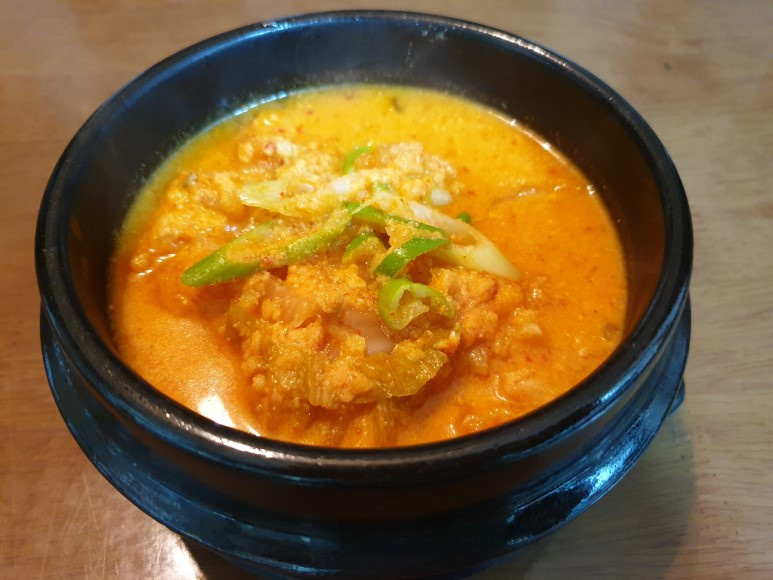Hearty and Savory Korean Soybean Paste Stew (Kongbiji Jjigae)
Simple and Delicious Kongbiji Jjigae Recipe

Whip up a comforting bowl of Korean Soybean Paste Stew (Kongbiji Jjigae) using fresh local soybeans. This rich and flavorful stew is perfect for a hearty, home-cooked meal, especially on a chilly day.
Main Ingredients- 1 block Soybean Paste (Kongbiji) (approx. 300-400g)
- 1 handful Pork (approx. 100g, for stew)
- 1/2 head Napa Cabbage Kimchi
- 1 Tbsp Perilla Oil (Deulgireum)
- 1 Tbsp Minced Garlic
- 2 Tbsp Kimchi Juice
- 1 Tbsp Gochugaru (Korean Red Pepper Flakes)
- A small amount of Scallion
Seasoning (Optional)- 2 Tbsp Anchovy Sauce (Chamchi Aek)
- A pinch of Soy Sauce or Salt
- A pinch of Dasida (MSG-based seasoning)
- 2 Tbsp Anchovy Sauce (Chamchi Aek)
- A pinch of Soy Sauce or Salt
- A pinch of Dasida (MSG-based seasoning)
Cooking Instructions
Step 1
The star ingredient, soybean paste (Kongbiji), was sourced from a local market. One block typically weighs around 300-400g, so you can adjust the quantity if needed. If your block is larger, feel free to use a bit less.

Step 2
Pork suitable for stews is recommended. Cuts like pork shoulder, butt, or shank with a good balance of fat and meat will add depth of flavor. You can also use leftover pork if you have any.

Step 3
Use well-fermented Napa cabbage kimchi for the best flavor. Finely chop the kimchi into bite-sized pieces; this helps the seasoning penetrate better and improves the texture.

Step 4
Now, let’s start cooking the stew. In a pot, heat 1 tablespoon of perilla oil over low heat. Add 1 tablespoon of minced garlic and sauté until fragrant. This step builds a wonderful aromatic base for the stew.

Step 5
Once the garlic is fragrant, add the prepared pork. Stir-fry until the exterior of the meat is no longer pink. The rendered fat from the pork will enhance the stew’s richness.

Step 6
When the pork is partially cooked, add the chopped kimchi to the pot. Stir-fry everything together. The kimchi will soften and meld with the garlic and pork, creating a delicious foundation for the stew.

Step 7
Add about 2 tablespoons of kimchi juice to the stir-fried mixture. This adds an extra layer of savory flavor and a pleasant tanginess. If you don’t have kimchi juice, you can omit it or add a little more water.

Step 8
Stir in 1 tablespoon of gochugaru (Korean red pepper flakes) for a gentle spice. Adjust the amount based on the spiciness of your kimchi and your preference.

Step 9
Mix all the ingredients thoroughly and continue to stir-fry for another 1-2 minutes. This brief cooking time helps the flavors meld together.

Step 10
Now, pour in water to cover the ingredients. For a stew consistency, you want the water to just submerge everything. It’s best to start with a moderate amount of water and add more later if needed, to avoid making the stew too thin.

Step 11
Add 2 tablespoons of anchovy sauce (Chamchi Aek) for a boost of umami. You can substitute this with regular soy sauce or fish sauce if preferred.

Step 12
Add the entire block of soybean paste (Kongbiji) to the pot. If it’s still in a solid block, use a spatula to break it up and mix it into the broth.

Step 13
Stir well to combine the soybean paste with the broth. Cover the pot and let it simmer gently over medium-low heat for about 20 minutes. This simmering time allows the soybean paste to break down and create a creamy texture. Remember to stir occasionally from the bottom to prevent sticking.

Step 14
After about 20 minutes, the stew should have thickened nicely. Taste the stew and adjust the seasoning. If it’s too bland, add a little soy sauce or salt. For an extra kick of flavor, a pinch of Dasida (MSG-based seasoning) can be added to suit your taste.

Step 15
Finally, add the sliced scallions and simmer for another minute. Your delicious Kongbiji Jjigae is ready! Serve it hot with a bowl of steamed rice for a satisfying meal.



